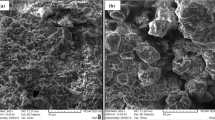Abstract
Problematic soils are those that make the construction of structures extremely difficult. They include collapsible soils which are widely distributed in North America, Europe, Russia and Asia. They show low dry density and moisture content in all testing schedule due to presence of cementation bonds or loess structure especially at unsaturated state in arid or semi-arid regions. Therefore, conditions in arid and semi-arid climates favor the formation of the most problematic collapsible soils. Arid and semi-arid soils are mainly found in the Middle east (Arabian desert). The basic objectives of this study are to describe the hydrocollapse properties and characteristics of semi-arid soils of Najran (Saudi Arabia), it also investigates the collapsibility characteristics and behavior of the materials with particular reference to their response to wetting under different stress levels. Undisturbed soil samples from Najran area situated in the south of Saudi Arabia have been collected and studied by using both single and double Oedometer tests. The results show that the highest value of collapse potential (CP = 12.76 %) of Najran soil is given by double Oedometer tests for a depth of 1.5 m which represents a very severe trouble.













Similar content being viewed by others
References
Clemence SP, Finbarr OA (1981) Design considerations for collapsible soils. J Geotech Eng Div, Am Soc Civ Eng 107(GT3):305–317
Sultan HA (1969) Foundation failures on collapsing soils in the Tucson, Arizona area. Proceedings, Second Conference on Expansive and Collapsing Soils. Texas A&M Press, College Station, pp 394–398
Rogers CDF (1995) Types and distribution of collapsible soils, Keynote Paper. Proceedings of NATO Workshop on Collapsible Soils, published by Kluwer Academic Press, 1–17
Derbyshire E, Dijkestra T, Smalley I (1995) Genesis and properties of collapsible soils. In: NATO ASI Series C: Mathematical and physical sciences, Kluwer Academic Publishers, The Netherlands, p 468
Mulvey WE (1992) Engineering geologic problems caused by soil and rock in southwestern Utah. In: Harty KM (ed) Engineering and environmental geology of southwestern, Utah Geological Association Publication, Utah 21, 139-144
Smalley IJ, Cabrera JG (1971) The shape and surface texture of loess particles, reply. Geol Soc Am 82:2361–2364
Rogers CDF, Dijkstra TA, Smalley IJ (1994) Hydroconsolidation and subsidence of loess: studies from China, Russia, North America and Europe. Eng Geol 37(1994):83–113
Jefferson I, Evstatiev D, Angelova R, Smalley IJ (1998) Improvement of loess soils in north-west Bulgaria for radioactive waste disposal, Proceedings of 2nd International Conference on Ground improvement techniques, Singapore, pp 207–212
Mellors TW (1995) The influence of the clay component in loess on collapse of the soil structure. In: Derbyshire E et al (eds) Genesis and properties of collapsible soils. Kluwer Academic Publishers, Kluwer, pp 207–216
Lin CY (1960) Structure of loess. Symposium on basic properties of loess, Civil Engineering and Architecture Institute of Chinese Academy of Sciences, Science Press, Beijing
Evstatiev D (1995) Design and treatment of loess bases in Bulgaria. In: Derbyshire E et al (eds) Genesis and properties of collapsible soils. Kluwer Academic Publishers, Kluwer, pp 375–382
Gao G (1996) The distribution and geotechnical properties of loess soils, lateritic soils and clayey soils in China. Eng Geol 42(1):95–104
Petrukhin VP (1993) Construction of structures on saline soil. A.A Balkema publishers, Rotterdam 255
Denisov NY (1951) The engineering properties of loess and loess-like soils (in Russian), Moscow (Gosstroiizdat),p 1–133
Jennings JL, Knight K (1975) A guide to construction on or with material exhibiting additional settlement due to collapse of grain structure. proceedings of the 6th Regional Conference for Africa on Soil Mechanics and Foundation Engineering. Durban, South Africa, pp 99–105
Yuan ZX, Wang LM (2009) Collapsibility and seismic settlement of loess. Eng Geol 105:119–123
Grabowska-Olszewska B (1988) Engineering geological problem of loess in Poland. Eng Geol 25:177–199
Phien-Wej N, Prentong T, Balasubramanian AS (1992) Collapse and strength characteristics of loess in Thailand. Eng Geol 32:59–72
Assallay AM (1998) Structure and hydocollapse behaveour of loess. Ph.D thesis, Loughborough University, UK
Basma AA, Tuncer ER (1992) Evaluation and control of collapsible soils. J Geotech Eng 118:1491–1504
Muhs DR, Mcgeehin JP, Beann J, Fisher E (2004) Holocene loess deposition and soil formation as competing processes Matanuska Valley, southern Alaska. Quat Res 61(3):265–276
Vilar OM, Rodrigues RA (2011) Collapse behavior of soil in a Brazilian region affected by a rising water table. Can Geotech J 48:226–233
Acknowledgments
This research work is supported by the Deanship of Scientific Research at Najran University, Saudi Arabia.
Author information
Authors and Affiliations
Corresponding author
Rights and permissions
About this article
Cite this article
Rouaiguia, A., Dahim, M.A. Hydrocollapse of Semi-arid Soils. Indian Geotech J 46, 25–33 (2016). https://doi.org/10.1007/s40098-015-0146-6
Received:
Accepted:
Published:
Issue Date:
DOI: https://doi.org/10.1007/s40098-015-0146-6




